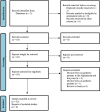A scoping review of two decades of pediatric humanitarian care during wartime
- PMID: 37166192
- PMCID: PMC10389486
- DOI: 10.1097/TA.0000000000004005
A scoping review of two decades of pediatric humanitarian care during wartime
Abstract
Abstract: Humanitarian care is a vital component of the wartime mission. Children comprise a significant proportion of casualties injured by explosives and penetrating weapons. Children face a variety of unique injury patterns in the combat setting as high-powered firearms and explosives are rarely seen in the civilian setting. We sought to perform a scoping review of pediatric research from the recent US-led wars in Afghanistan, and Iraq conflicts beginning in 2001. We used Google Scholar and PubMed to identify pediatric combat literature published between 2001 and 2022. We utilized the PRISMA-ScR Checklist to conduct this review. We identified 52 studies that met inclusion for this analysis-1 prospective observational study, 50 retrospective studies, and 1 case report. All the original research studies were retrospective in nature except for one. We identified one prospective study that was a post hoc subanalysis from an overall study assessing the success of prehospital lifesaving interventions. Most of the articles came from varying registries created by the United States and British militaries for the purposes of trauma performance improvement. The deployed health service support mission often includes treatment of pediatric trauma patients. The deployed health service support mission often includes treatment of pediatric trauma patients. We found that available literature from this setting is limited to retrospective studies except for one prospective study. Our findings suggest that pediatric humanitarian care was a significant source of medical resource consumption within both of the major wars. Further, many of the lessons learned have directly translated into changes in civilian pediatric trauma care practices highlighting the need for collaborative scientific developments between the military and civilian trauma programs.
Level of evidence: Systematic Review/Meta-Analyses; Level III.
Copyright © 2023 Written work prepared by employees of the Federal Government as part of their official duties is, under the U.S. Copyright Act, a “work of the United States Government” for which copyright protection under Title 17 of the United States Code is not available. As such, copyright does not extend to the contributions of employees of the Federal Government.
Figures
Similar articles
-
U.S. Military Medical Evacuation and Prehospital Care of Pediatric Trauma Casualties in Iraq and Afghanistan.Prehosp Emerg Care. 2020 Mar-Apr;24(2):265-272. doi: 10.1080/10903127.2019.1626956. Epub 2019 Jun 19. Prehosp Emerg Care. 2020. PMID: 31157581
-
Characterization of Humanitarian Trauma Care by US Military Facilities During Combat Operations in Afghanistan and Iraq.Ann Surg. 2022 Oct 1;276(4):732-742. doi: 10.1097/SLA.0000000000005592. Epub 2022 Jul 15. Ann Surg. 2022. PMID: 35837945
-
Emergency department imaging of pediatric trauma patients during combat operations in Iraq and Afghanistan.Pediatr Radiol. 2018 May;48(5):620-625. doi: 10.1007/s00247-017-4065-9. Epub 2018 Jan 6. Pediatr Radiol. 2018. PMID: 29307034
-
Imaging of pediatric pathology during the Iraq and Afghanistan conflicts.Pediatr Radiol. 2015 Mar;45(3):439-48. doi: 10.1007/s00247-014-3025-x. Epub 2014 Jun 5. Pediatr Radiol. 2015. PMID: 24898394 Review.
-
A Scoping Review of Military Combat Casualty Data on Submassive, Massive, and Supermassive Transfusions.Mil Med. 2025 Jan 16;190(1-2):e99-e106. doi: 10.1093/milmed/usae349. Mil Med. 2025. PMID: 39073394
References
-
- Burnett MW, Callahan CW. American pediatricians at war: a legacy of service. Pediatrics. 2012;129(Suppl 1):S33–S49. - PubMed
-
- Edwards MJ, Lustik M, Burnett MW, Eichelberger M. Pediatric inpatient humanitarian care in combat: Iraq and Afghanistan 2002 to 2012. J Am Coll Surg. 2014;218(5):1018–1023. - PubMed
-
- Gurney JM, Graf V, Staudt AM, Trevino JD, VanFosson CA, Wild H, Wren SM. Characterization of humanitarian trauma care by US military facilities during combat operations in Afghanistan and Iraq. Ann Surg. 2022;276(4):732–742. - PubMed
-
- Walker AJ. The ‘Walker dip’. J R Nav Med Serv. 2018;104(3):173–176.
-
- Schauer SG, April MD, Hill GJ, Naylor JF, Borgman MA, De Lorenzo RA. Prehospital interventions performed on pediatric trauma patients in Iraq and Afghanistan. Prehosp Emerg Care. 2018;22(5):624–629. - PubMed
Publication types
MeSH terms
Substances
LinkOut - more resources
Full Text Sources
Research Materials
Miscellaneous



